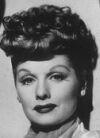Left fatherless at the age of four, American actress Lucille Ball developed a strong work ethic in childhood; among her more unusual jobs was as a "seeing eye kid" for a blind soap peddler. Ball's mother sent the girl to the Chautauqua Institution for piano lessons, but she was determined to pursue an acting career after watching the positive audience reaction given to vaudeville monologist Julius Tannen. Young Ball performed in amateur plays for the Elks club and at her high school, at one point starring, staging, and publicizing a production of Charley's Aunt. In 1926, Ball enrolled in the John Murray Anderson American Academy of Dramatic Art in Manhattan (where Bette Davis was the star pupil), but was discouraged by her teachers to continue due to her shyness. Her reticence notwithstanding, Ball kept trying until she got chorus-girl work and modeling jobs; but even then she received little encouragement from her peers, and the combination of a serious auto accident and recurring stomach ailments seemed to bode ill for her theatrical future. Still, Ball was no quitter, and, in 1933, she managed to become one of the singing/dancing Goldwyn Girls for movie producer Samuel Goldwyn; her first picture was Eddie Cantor's Roman Scandals (1933). Working her way up from bit roles at both Columbia Pictures (where one of her assignments was in a Three Stooges short) and RKO Radio, Ball finally attained featured billing in 1935, and stardom in 1938 — albeit mostly in B-movies. Throughout the late 1930s and '40s, Ball's movie career moved steadily, if not spectacularly; even when she got a good role like the nasty-tempered nightclub star in The Big Street (1942), it was usually because the "bigger" RKO contract actresses had turned it down. By the time she finished a contract at MGM (she was dubbed "Technicolor Tessie" at the studio because of her photogenic red hair and bright smile) and returned to Columbia in 1947, she was considered washed up. Ball's home life was none too secure, either. She'd married Cuban bandleader Desi Arnaz in 1940, but, despite an obvious strong affection for one another, they had separated and considered divorce numerous times during the war years. Hoping to keep her household together, Ball sought out professional work in which she could work with her husband. Offered her own TV series in 1950, she refused unless Arnaz would co-star. Television was a godsend for the couple; and Arnaz discovered he had a natural executive ability, and was soon calling all the shots for what would become I Love Lucy. From 1951 through 1957, it was the most popular sitcom on television, and Ball, after years of career stops and starts, was firmly established as a megastar in her role of zany, disaster-prone Lucy Ricardo. When her much-publicized baby was born in January 1953, the story received more press coverage than President Eisenhower's inauguration. With their new Hollywood prestige, Ball and Arnaz were able to set up the powerful Desilu Studios production complex, ultimately purchasing the facilities of RKO, where both performers had once been contract players. But professional pressures and personal problems began eroding the marriage, and Ball and Arnaz divorced in 1960, although both continued to operate Desilu. Ball gave Broadway a try in the 1960 musical Wildcat, which was successful but no hit, and, in 1962, returned to TV to solo as Lucy Carmichael on The Lucy Show. She'd already bought out Arnaz's interest in Desilu, and, before selling the studio to Gulf and Western in 1969, Ball had become a powerful executive in her own right, determinedly guiding the destinies of such fondly remembered TV series as Star Trek and Mission: Impossible. The Lucy Show ended in the spring of 1968, but Ball was back that fall with Here's Lucy, in which she played "odd job" specialist Lucy Carter and co-starred with her real-life children, Desi Jr. and Lucie. Here's Lucy lasted until 1974, at which time her career took some odd directions. She poured a lot of her own money in a film version of the Broadway musical Mame (1974), which can charitably be labeled an embarrassment. Her later attempts to resume TV production, and her benighted TV comeback in the 1986 sitcom Life With Lucy, were unsuccessful, although Ball, herself, continued to be lionized as the First Lady of Television, accumulating numerous awards and honorariums. Despite her many latter-day attempts to change her image — in addition to her blunt, commandeering off-stage personality — Ball would forever remain the wacky "Lucy" that Americans had loved intensely in the '50s. She died in 1989. |

